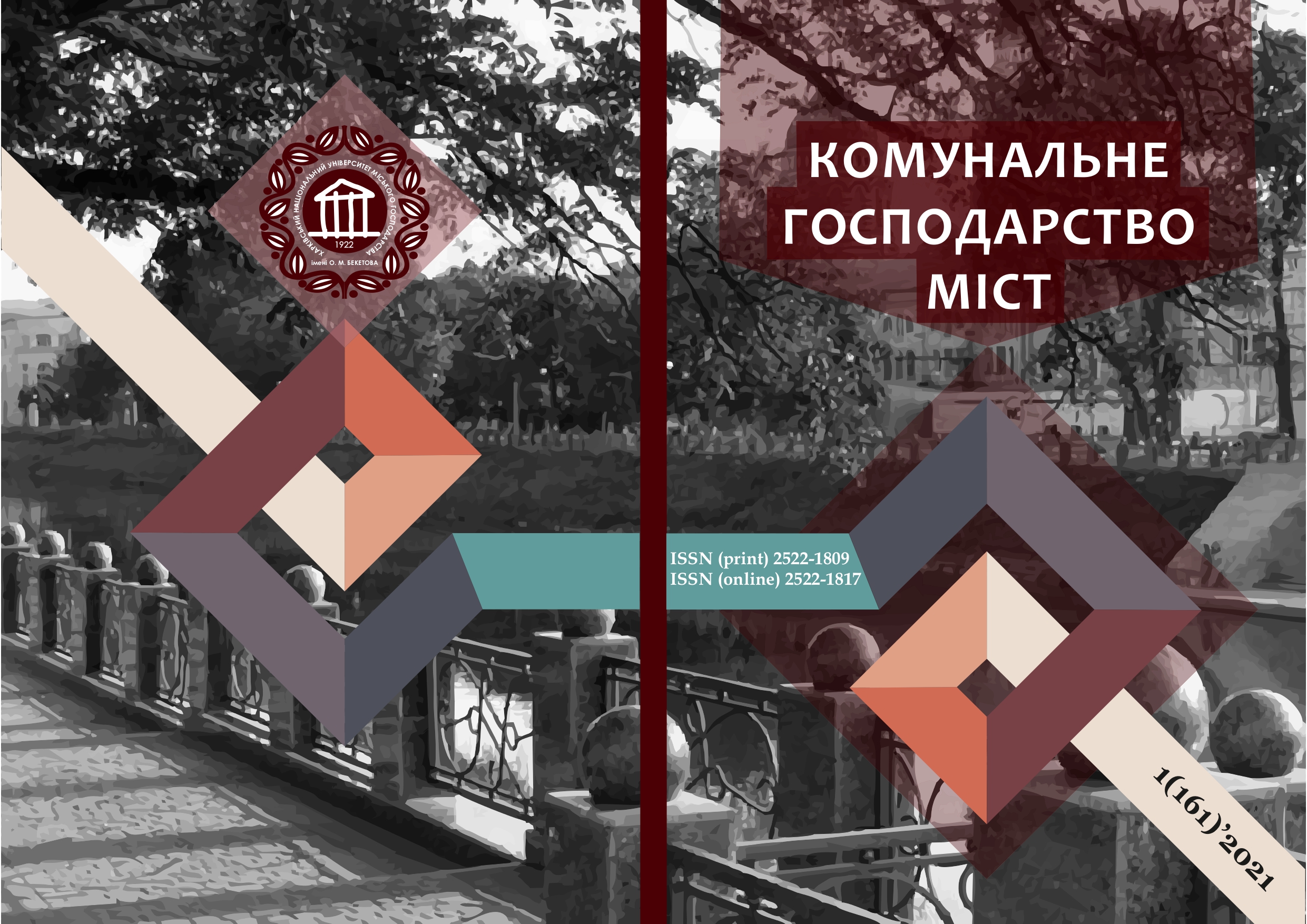ЕЛЕКТРОФЛОТАЦІЙНА ОЧИСТКА СТІЧНИХ ВОД МОЛОКОЗАВОДІВ: ХІМІКО-ТЕХНОЛОГІЧНІ АСПЕКТИ
Array
Ключові слова:
стічні води, молокозавод, етеророзчинні речовини, електрофлотація, реагент, ступінь очистки.Анотація
Експериментально встановлені хіміко-технологічні закономірності реагентно-електрофлотаційної очистки стічних вод молокозаводів. Показано, що найбільший ступінь очищення від етеророзчинних речовин 87-88% забезпечується додаванням ферум хлориду FeCl3 в концентрації 150-200мг/дм3 при рН середовища 9,5-10, а зниження вмісту етеророзчинних речовин до 40мг/дм3 можливо при високій густини електричного струму та тривалій електрофлотації..
Посилання
2. Shevchenko, T.A., Shevchenko, A.A. (2015). Experimental study of intensification of the process of pressure flotation during wastewater treatment of a milk processing enterprise, Eastern European Journal of Advanced Technologies, 1/6 (79), 4-12.
3. Andronov, V. A., Makarov, Ye. O., Danchenko, Yu. M., Obizhenko, T.M. (2020). Research of the regularities of forming and chemical composition of sewage water of a dairy processing company, Technogenic and ecological safety, 7, (1/2020), 13-21.
4. Makarov, Ye. O. (2020). Environmentally friendly high-concentration waste waters of milk processing plants, Sustainable Development - Status and Prospects: Proceedings of the II International Symposium SDEV’2020. Lviv, 235-236.
5. Konevych, M., Hud, V. (2011). Features of dairy wastewater, Proceedings of the XV scientific conference of TNTU named after Ivan Pulyuy. Ternopil, 309.
6. Gerson de Freitas Silva Valente, Regina Celia Santos Mendonca, Jose Antonio Marques Pereira (2015). The efficiency of electrocoagulation using aluminum electrodes in treating wastewater from a dairy industry, Ciencia Rural, Santa Maria, 45, 9, 1713–1719.
7. Chezeau, B., Boudriche, L., Vial, C. and Boudjemaa, A. (2019). Treatment of dairy wastewater by electrocoagulation process: Advantages of combined iron/aluminum electrodes (published online 15.07.2019), Separation Science and Technology, 15.
8. Aitbara, A., Cherifi, M., Hazourli, S. and Leclerc, J.-P. (2016). Continuous treatment of industrial dairy effluent by electrocoagulation using aluminum electrodes, Desalination and Water Treatment, 57, 8, 3395-3404.
9. Benaissa, F., Kermet-Said, H. and Moulai-Mostera, N. (2016). Optimization and kinetic modeling of electrocoagulation treatment of dairy wastewater, Desalination and Water Treatment, 57, 13, 5988-5994.
10. Varank, G., Sabuncu, M.E. (2015). Application of Central Composite Design approach for dairy wastewater treatment by electrocoagulation using iron and aluminum electrodes: modeling and optimization, Desalination and Water Treatment, 56, 1, 33-54.
11. Ozornova, A.V. (2016). Investigation of the flotation process of dairy production wastewater treatment and development of a method for its intensification, Youth scientific and technical bulletin, 11, 20.
12. Ternovska, O. I., Kovtun, S. B., Kukushkin, A. I., Diakonov, V. I., Chebotariova, O. V., Fesenko, H. V. (2015). Treatment of industrial effluents of enterprises for processing livestock products from fat, Municipal economy of cities, 124, 39-42.
13. Brodskii, V. A., Kisilenko, P. N., Kolesnikov, V. A., Gordienko, M. G. (2016). Electroflotation extraction of protein suspensions from aqueous solutions, Advances in chemistry and chemical technology, XXX, 3, 46-48.
14. Kalinina-Shuvalova, S. F. (2013). Dairy industry wastewater treatment by flotation, New ideas of the new century: materials of the international scientific conference FAD TOGU, 2, 304-308.
15. Kalinina-Shuvalova, S. F., Kritskaia, A. F. (2013). Technological schemes for the treatment of greasy wastewater, Far East: problems of development of the architectural and construction complex, 1, 313-319.
16. Sukharev, Yu. I., Gofman, V. R., Nikolaienko, Ye. V., Abdrashitov, R. R. (1999). Investigation of the process of electroflotation of fats from wastewater, Bulletin of the Chelyabinsk Scientific Center of the Ural Branch of the Russian Academy of Sciences, 1, 121-130.
17. Physicochemical methods of wastewater treatment of dairy industry enterprises, Whole milk industry: overview information TSNIITEImyasomolprom, 44.
18. Matov, B. M., Napadenskii, R. Ya. (1985). Electrochemical stability of anode materials in the process of electrochemical wastewater treatment, Methods for the analysis of natural and waste water treatment, 47-49.
19. Iliin, V. I. (2014). Electroflotation. Development ways, Electroplating and surface treatment, 22, 4, 49-52.
20. Iliin, V. I., Brodskii, V. A., Kolesnikov, V. A. (2015). Development of technological solutions for wastewater treatment from organic pollution, Water treatment. Water treatment. Water supply, 4, 16-19.
21. Karataiev, O. R., Shamsutdinova, Z. R., Khafizov, I. I. (2015). Wastewater treatment by electrochemical methods, Technological University Bulletin,18, 22, 21-23.
22. Lurie, Yu. Yu. (1984). Analytical chemistry of industrial wastewater, M.: "Chemistry", 448.
##submission.downloads##
Опубліковано
Як цитувати
Номер
Розділ
Ліцензія
Автори, які публікуються у цьому збірнику, погоджуються з наступними умовами:
- Автори залишають за собою право на авторство своєї роботи та передають журналу право першої публікації цієї роботи на умовах ліцензії CC BY-NC-ND 4.0 (із Зазначенням Авторства – Некомерційна – Без Похідних 4.0 Міжнародна), котра дозволяє іншим особам вільно розповсюджувати опубліковану роботу з обов'язковим посиланням на авторів оригінальної роботи та першу публікацію роботи у цьому журналі.
- Автори мають право укладати самостійні додаткові угоди щодо неексклюзивного розповсюдження роботи у тому вигляді, в якому вона була опублікована цим журналом (наприклад, розміщувати роботу в електронному сховищі установи або публікувати у складі монографії), за умови збереження посилання на першу публікацію роботи у цьому журналі.
- Політика журналу дозволяє і заохочує розміщення авторами в мережі Інтернет (наприклад, у сховищах установ або на особистих веб-сайтах) рукопису роботи, як до подання цього рукопису до редакції, так і під час його редакційного опрацювання, оскільки це сприяє виникненню продуктивної наукової дискусії та позитивно позначається на оперативності та динаміці цитування опублікованої роботи (див. The Effect of Open Access).

